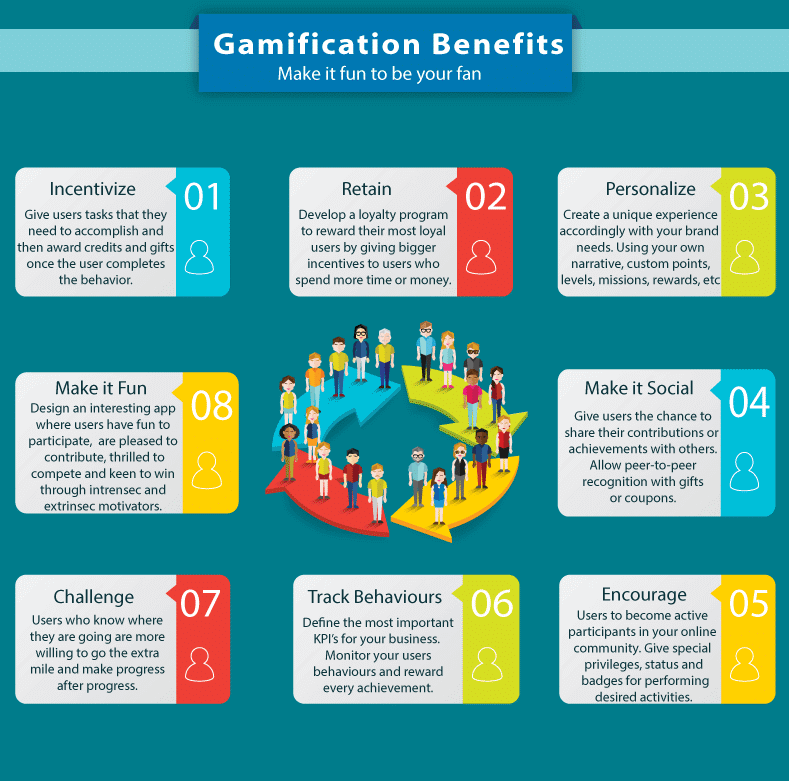As discussed in a previous piece, gamification is the practice of incorporating game elements, mechanics and principles and introducing them to non-game environments in order to engage users more effectively. It takes the fun, engaging parts of games and applies them to real-world, non-game activities.
But what are the major benefits of gamification? What justifies the financial and manpower investment into gamifying a digital platform?
Key Benefits of Gamification
- Higher Engagement: Turns out, even when the TV is on, millennials are focused on their phones. It is safe to assume that they aren’t watching commercially too carefully when they could be playing Grand Theft Auto on their phone.
Games engage users in a way video cannot. It draws them into a participatory, interactive relationship. By actually undertaking steps to advance through levels, overcome obstacles and communicate with other players, individuals have a much deeper emotional resonance with games. Compare this with the one-sided viewer-video relationship, and you can start to imagine why gamification drives engagement.
Whether targeted at employees of a company or potential customers of a brand, gamification actually entertains the target audience. When having fun, individuals are a lot less likely to see the content as study material or marketing collateral. It provides them with a burst of stimulation and attaches positive emotion to the brand and the gamified material itself.
To quote Gartner, “When successfully designed, gamification apps enhance user engagement and drive customer acquisition and retention.” - Fosters better learning: According to game developer and author Jane McGonigal, “By 21 years of age, many males will have spent over 10,000 hours immersed in online gaming” She has also explored the science behind “why games are good for us–why they make us happier, more creative, more resilient, and better able to lead others in world-changing efforts.”
Individuals are geared to respond positively to the challenge-and-reward structure inherent in games. If utilized in learning modules and classrooms, gamification has the potential (and proven ability) to encourage more investment in the lessons, provide a sense of achievement and nurture healthy competition between students.
The same results can be replicated in workplaces when it comes to training new employees or upskilling existing employees. Gamification can help them connect to the material, retain more knowledge and develop a sense of pride in mastering new ideas and skills. - Offers Instant Feedback: A key aspect of game dynamics is to offer instant feedback. When people tend to know how they are progressing with an activity, they will care more about the outcome. They will also put in more effort to do well, in an attempt to receive positive feedback at the end of each challenge/quest/mission. This encourages, once again, deeper engagement, higher retention and recall.
- Encourages behavioural change: As the pointers above demonstrate, gamification has the ability to change behavioural patterns, at least while someone is actively communicating with game mechanics. By leveraging this ability to influence behaviour, gamification can be used to promote better learning, greater focus and more positive, people-based outcomes. Anything from a more attentive student to a more productive employee can be the result of an efficiently gamified app.

Examples of Gamification in Action
- Tinycards by Duolingo: Tinycards takes the old concept of learning via flashcards and makes it interesting. Just pick a subject, and the app will initiate a learning process with flashcards.
A couple examples of gamification: as a user goes through a deck of flashcards, the progress bar reflects their advancements and eventually awards them with various accomplishments. Users can even get creative and craft their own flashcards. - Memrise: A gamified language app with a plethora of game-derived elements, Memrise is known for its fun and easy-to-use interface. Users take the form of astronauts, off to outer space on a journey to pick up a new language. They learn, advance in levels and while doing so, are accompanied by a similarly evolving pet alien.
- SoloLearn: SoLoLearn uses gamification to teach code. It hosts player challenges, a Code Playground for players to display their code and gather feedback, as well as a leaderboard that celebrates the best coders. You can build your own code and apps, present it on the Playground, and have others on the app upvote it, use it and provide instant feedback.
- Goama: Goama gamifies other apps to increase user acquisition and retention, engagement, and open up even more revenue streams. We do more than just badges, leaderboards, and points when we gamify app, we actually turn your app into a place where users can enjoy games and win real rewards. You can learn more on how we gamify apps here.

As these examples depict, the benefits of gamification are established and impossible to ignore. They give users a reason to care about a website or app, and actually pay attention to the content being displayed. It has tangible effects on users’ brain chemistry, behaviour and eventually, real-world action.
The very real benefits of gamification make it a sound and future-proof investment for any organization that wants to get people interested, engaged and retain their mindfulness. In an age of lower attention spans, instant gratification and agility-as-priority, gamification promises to become a best practice rather than just a fascinating novelty.
Want to know more about gamification and how we can gamify your app? Contact us here.

